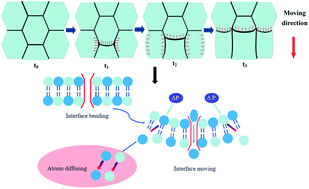当前位置:
X-MOL 学术
›
CrystEngComm
›
论文详情
Our official English website, www.x-mol.net, welcomes your
feedback! (Note: you will need to create a separate account there.)
The growth behavior of columnar grains in a TiAl alloy during directional induction heat treatments
CrystEngComm ( IF 2.6 ) Pub Date : 2020/01/09 , DOI: 10.1039/c9ce01631g Yangli Liu 1, 2, 3, 4 , Xiang Xue 1, 2, 3, 4 , Hongze Fang 1, 2, 3, 4 , Yingmei Tan 1, 2, 3, 4 , Ruirun Chen 1, 2, 3, 4, 5 , Yanqing Su 1, 2, 3, 4 , Jingjie Guo 1, 2, 3, 4
CrystEngComm ( IF 2.6 ) Pub Date : 2020/01/09 , DOI: 10.1039/c9ce01631g Yangli Liu 1, 2, 3, 4 , Xiang Xue 1, 2, 3, 4 , Hongze Fang 1, 2, 3, 4 , Yingmei Tan 1, 2, 3, 4 , Ruirun Chen 1, 2, 3, 4, 5 , Yanqing Su 1, 2, 3, 4 , Jingjie Guo 1, 2, 3, 4
Affiliation

|
In general, columnar grains can be easily obtained in a directional solidification process. However, in this study, columnar grains were achieved via a directional induction heat treatment (DHT). A TiAl ingot with equiaxed grains was induction-heated at 1750 K and preserved for 20 min. Then, it was pulled down into a liquid Ga–In alloy with a velocity of 4.17 μm s−1. The liquid Ga–In alloy was used for cooling the ingot at the bottom. The results show that the grains grow from the equiaxed to columnar after a competitive growth. The length of the directional growth zone is about 25 mm and the maximum length of columnar grains is 15.5 mm. Lamella orientation with a small angle (less than 60°) is about 90% in all the columnar grains, which is higher than that of the ingot prepared via a traditional directional solidification. The driving force for the columnar grain growth is the bending interface tension caused by the heat transfer from the induction heating zone to the bottom. The atoms in front of the interface will diffuse downward under the action of interface tension during DHT; therefore, the grains will grow up along the axial direction. The interface migration rate (namely growth rate) of the columnar grains was calculated based on the model of interface continuous moving. The calculated results indicate that the interface migration rate ranged from 0.350–0.505 μm s−1 at 1750 K.
中文翻译:

定向感应热处理过程中TiAl合金中柱状晶粒的生长行为
通常,在定向凝固过程中可以容易地获得柱状晶粒。然而,在这项研究中,柱状晶粒是通过定向感应热处理(DHT)获得的。将具有等轴晶粒的TiAl锭感应加热至1750 K,并保存20分钟。然后,将其以4.17μms -1的速度拉入液态Ga-In合金中。液态Ga-In合金用于冷却底部的铸锭。结果表明,经过竞争性生长,晶粒从等轴生长到柱状。定向生长区的长度约为25mm,柱状晶粒的最大长度为15.5mm。在所有圆柱状晶粒中,小角度(小于60°)的薄片取向约为90%,高于所制备的铸锭的取向通过传统的定向凝固。柱状晶粒长大的驱动力是由于从感应加热区到底部的热传递而引起的弯曲界面张力。在DHT过程中,界面前的原子将在界面张力的作用下向下扩散;因此,晶粒将沿轴向长大。基于界面连续移动模型,计算出圆柱状晶粒的界面迁移速率(即生长速率)。计算结果表明,在1750 K时,界面迁移速率为0.350-0.505μms -1。
更新日期:2020-02-17
中文翻译:

定向感应热处理过程中TiAl合金中柱状晶粒的生长行为
通常,在定向凝固过程中可以容易地获得柱状晶粒。然而,在这项研究中,柱状晶粒是通过定向感应热处理(DHT)获得的。将具有等轴晶粒的TiAl锭感应加热至1750 K,并保存20分钟。然后,将其以4.17μms -1的速度拉入液态Ga-In合金中。液态Ga-In合金用于冷却底部的铸锭。结果表明,经过竞争性生长,晶粒从等轴生长到柱状。定向生长区的长度约为25mm,柱状晶粒的最大长度为15.5mm。在所有圆柱状晶粒中,小角度(小于60°)的薄片取向约为90%,高于所制备的铸锭的取向通过传统的定向凝固。柱状晶粒长大的驱动力是由于从感应加热区到底部的热传递而引起的弯曲界面张力。在DHT过程中,界面前的原子将在界面张力的作用下向下扩散;因此,晶粒将沿轴向长大。基于界面连续移动模型,计算出圆柱状晶粒的界面迁移速率(即生长速率)。计算结果表明,在1750 K时,界面迁移速率为0.350-0.505μms -1。











































 京公网安备 11010802027423号
京公网安备 11010802027423号